多线程学习(二)

线程同步
多个线程操作同一个资源
并发:同一个对象被多个线程同时操作
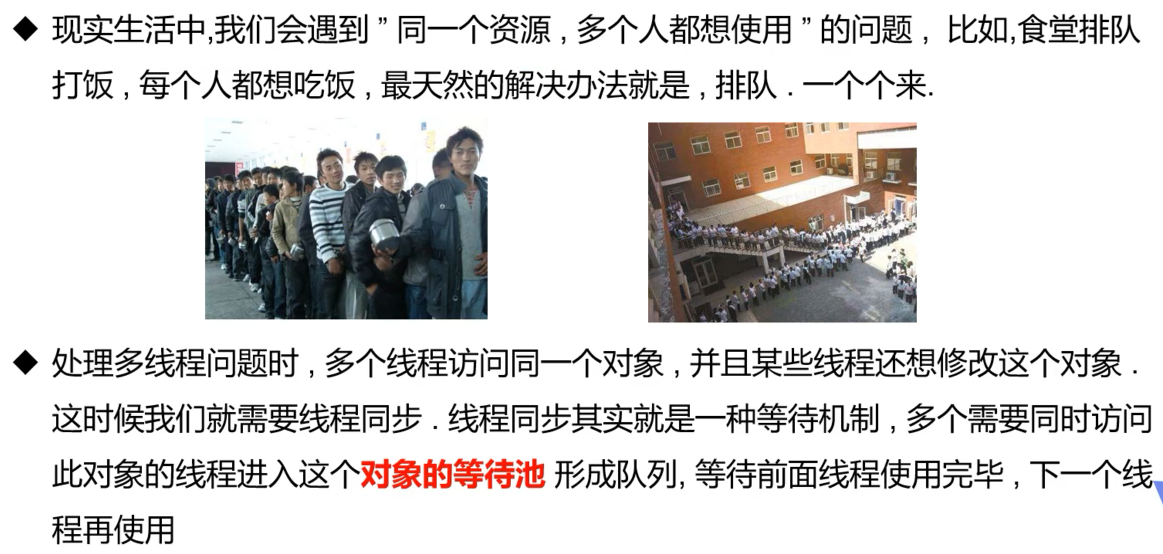
队列和锁:实现线程同步需要队列和锁
队列和锁的理解可以联想排队上厕所:队列就像等待上厕所的队伍,锁就像蹲坑的门,当你进去时把门关上,则其他人就进不去了,如果没有门(锁)就不能独占资源,也就没有了安全性

三大不安全案例
//不安全的买票
public class UnsafeBuyTicket {
public static void main(String[] args) {
// TODO Auto-generated method stub
BuyTicket station = new BuyTicket();
new Thread(station,"苦逼的我").start();
new Thread(station,"牛逼的大家").start();
new Thread(station,"可恶的黄牛").start();
}
}
class BuyTicket implements Runnable{
//票
private int ticketNums = 10;
boolean flag = true;//外部停止方式
@Override
public void run() {
//买票
while(flag)
{
try{
buy();
}catch(InterruptedException e)
{
e.printStackTrace();
}
}
}
private void buy() throws InterruptedException{
//判断是否有票
if(ticketNums<=0)
{
return;
}
//模拟延时
Thread.sleep(100);
//买票
System.out.println(Thread.currentThread().getName()+"拿到了"+ticketNums--+"票");
}
}
输出结果:(拿票混乱,且出现负数)

//不安全的取钱
//两个人去银行取钱,账户
public class UnsafeBank {
public static void main(String[] args) {
// TODO Auto-generated method stub
Account a = new Account(100,"结婚基金");
Drawing you = new Drawing(a,50,"你");
Drawing girl = new Drawing(a,100,"girl");
you.start();
girl.start();
}
}
//账户
class Account{
int money;//余额
String name;//卡名
public Account(int money,String name)
{
this.money = money;
this.name = name;
}
}
//银行:模拟取款
class Drawing extends Thread{
Account account;//账户
int drawingMoney;//取了多少钱
int nowMoney;//现在手里有多少钱
public Drawing(Account account,int drawingMoney,String name) {
super(name); //定义线程名
this.account = account;
this.drawingMoney = drawingMoney;
}
//取钱
@Override
public void run() {
//判断有没有钱
if(account.money-drawingMoney<0)
{
System.out.println(Thread.currentThread().getName()+"钱不够");
return;
}
//sleep可以放大问题的发生性
try {
Thread.sleep(1000);
}catch(Exception e)
{
e.printStackTrace();
}
//卡内余额=余额-你取的钱
account.money = account.money-drawingMoney;
//你手里的钱
nowMoney = nowMoney + drawingMoney;
System.out.println(account.name+"余额为"+account.money);
//这两个操作等价
//this.getName()=Thread.currentThread().getName()
System.out.println(this.getName()+"手里的钱"+nowMoney);
}
}
输出结果:(存款为负数)

//线程不安全的集合
public class UnsafeList {
public static void main(String[] args) {
// TODO Auto-generated method stub
List<String> list = new ArrayList<String>();
for(int i=0;i<10000;i++)
{
new Thread(()->{
list.add(Thread.currentThread().getName());
}).start();
}
try {
Thread.sleep(3000);
}catch(Exception e)
{
e.printStackTrace();
}
System.out.println(list.size());
}
}
输出结果:(不足10000,因为存在多个线程同时看到一个标志,于是name就存在被覆盖掉的可能)

同步方法及同步块(synchronized)(把不安全的改成安全的)
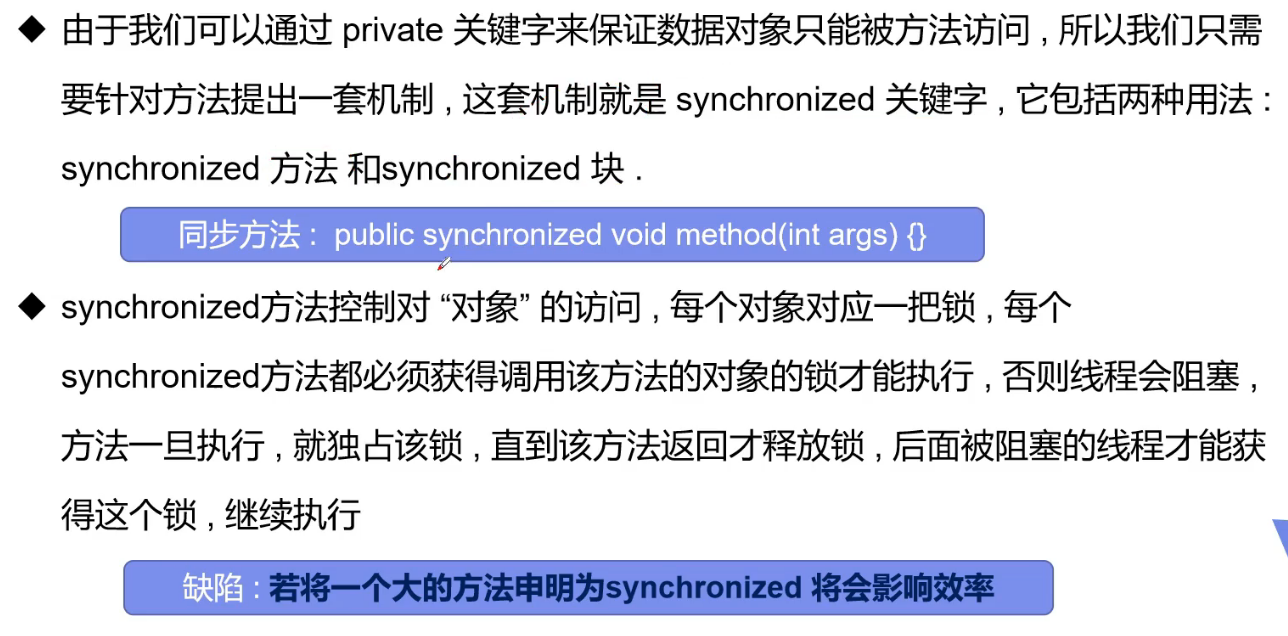
//加锁,同步方法,实现安全的买票
public class UnsafeBuyTicket {
public static void main(String[] args) {
// TODO Auto-generated method stub
BuyTicket station = new BuyTicket();
new Thread(station,"苦逼的我").start();
new Thread(station,"牛逼的大家").start();
new Thread(station,"可恶的黄牛").start();
}
}
class BuyTicket implements Runnable{
//票
private int ticketNums = 10;
boolean flag = true;//外部停止方式
@Override
public void run() {
//买票
while(flag)
{
try{
buy();
}catch(InterruptedException e)
{
e.printStackTrace();
}
}
}
//同步方法,锁的是BuyTicket类实例出的对象
private synchronized void buy() throws InterruptedException{
//判断是否有票
if(ticketNums<=0)
{
return;
}
//模拟延时
Thread.sleep(100);
//买票
System.out.println(Thread.currentThread().getName()+"拿到了"+ticketNums--+"票");
}
}
输出结果:(输出结果整洁有序,没有重复,没有负数)

同步方法的弊端
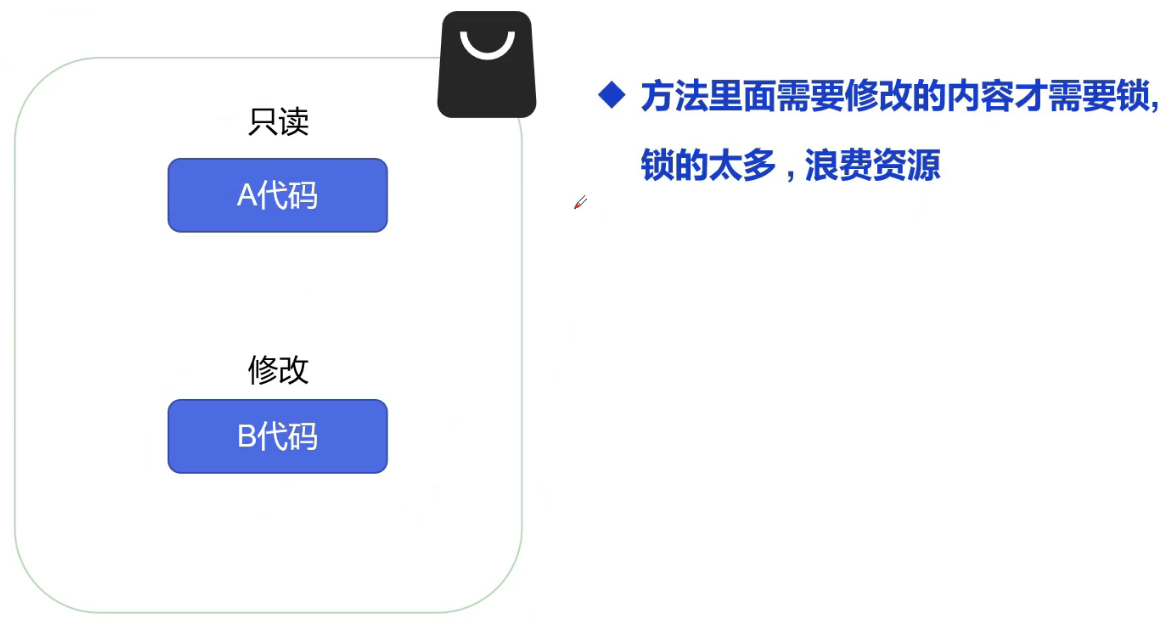
同步块
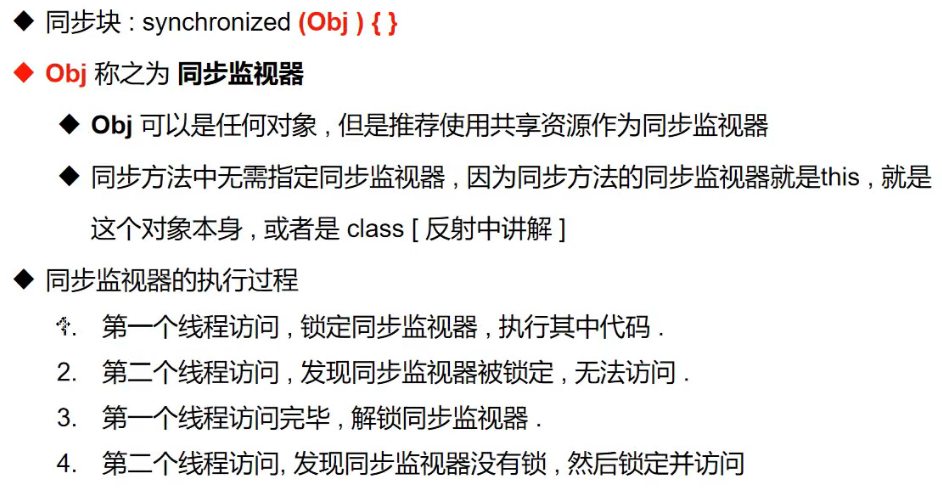
//使用方法块,找准修改的对象作为同步监视器来实现安全的取钱
//两个人去银行取钱,账户
public class UnsafeBank {
public static void main(String[] args) {
// TODO Auto-generated method stub
Account a = new Account(100,"结婚基金");
Drawing you = new Drawing(a,50,"你");
Drawing girl = new Drawing(a,100,"girl");
you.start();
girl.start();
}
}
//账户
class Account{
int money;//余额
String name;//卡名
public Account(int money,String name)
{
this.money = money;
this.name = name;
}
}
//银行:模拟取款
class Drawing extends Thread{
Account account;//账户
int drawingMoney;//取了多少钱
int nowMoney;//现在手里有多少钱
public Drawing(Account account,int drawingMoney,String name) {
super(name); //定义线程名
this.account = account;
this.drawingMoney = drawingMoney;
}
//取钱
// 如果直接在run方法前加锁,默认是锁的是调用该方法的对象,即Drawing类的实例化对象,
// 而我们这里实际上是对account这个共享资源做修改,故应该对account加锁
@Override
public void run() {
// 是对account加锁,account称之为同步监视器
// 锁的对象就是变化的量,需要增删改操作的对象
synchronized (account){
//判断有没有钱
if(account.money-drawingMoney<0)
{
System.out.println(Thread.currentThread().getName()+"钱不够");
return;
}
//sleep可以放大问题的发生性
try {
Thread.sleep(1000);
}catch(Exception e)
{
e.printStackTrace();
}
//卡内余额=余额-你取的钱
account.money = account.money-drawingMoney;
//你手里的钱
nowMoney = nowMoney + drawingMoney;
System.out.println(account.name+"余额为"+account.money);
//这两个操作等价
//System.out.println(this.getName()+Thread.currentThread().getName());
System.out.println(this.getName()+"手里的钱"+nowMoney);
}
}
}
输出结果:(不会出现负数了)

//使用同步块实现线程安全的集合
public class UnsafeList {
public static void main(String[] args) {
// TODO Auto-generated method stub
List<String> list = new ArrayList<String>();
for(int i=0;i<10000;i++)
{
new Thread(()->{
//使用同步块
synchronized (list){
list.add(Thread.currentThread().getName());
}
}).start();
}
try {
Thread.sleep(3000);
}catch(Exception e)
{
e.printStackTrace();
}
System.out.println(list.size());
}
}
输出结果:(size正确)

CopyOnWriteArrayList
import java.util.concurrent.CopyOnWriteArrayList;
//测试JUC安全类型的集合,使用juc下的集合不用添加同步块就可实现线程的同步
public class TestJUC {
public static void main(String[] args) {
// TODO Auto-generated method stub
CopyOnWriteArrayList<String> list = new CopyOnWriteArrayList<String>();
for(int i=0;i<10000;i++)
{
new Thread(()->{
list.add(Thread.currentThread().getName());
}).start();
}
try {
Thread.sleep(3000);
}catch(Exception e)
{
e.printStackTrace();
}
System.out.println(list.size());
}
}
死锁

注意:一个同步块同时拥有“两个以上对象的锁”时,就可能会发生“死锁”问题!
制造死锁:
//死锁:多个线程相互抱着对方需要的资源,然后形成死锁
public class DeadLock {
public static void main(String[] args) {
Makeup g1 = new Makeup(0,"灰姑娘");
Makeup g2 = new Makeup(1,"白雪公主");
g1.start();
g2.start();
}
}
//口红
class Lipstick{
}
//镜子
class Mirror{
}
class Makeup extends Thread{
//需要的资源只有一份,用static来保证只有一份
static Lipstick lipstick = new Lipstick();
static Mirror mirror = new Mirror();
int choice; //选择
String girlName; //使用化妆品的人
Makeup(int chioce,String girlName){
this.choice = chioce;
this.girlName = girlName;
}
@Override
public void run(){
//化妆
try {
makeup();
} catch (InterruptedException e) {
e.printStackTrace();
}
}
//化妆,互相持有对方的锁,就是需要拿到对象的资源
private void makeup() throws InterruptedException {
if (choice==0){
synchronized (lipstick){
System.out.println(this.girlName+"获得口红的锁");
Thread.sleep(1000);
//下面代码是在synchronized (lipstick){}里面
synchronized (mirror){ //一秒钟后想获得镜子
System.out.println(this.girlName+"获得镜子的锁");
}
}
}else{
synchronized (mirror){ //获得镜子的锁、
System.out.println(this.girlName+"获得镜子的锁");
Thread.sleep(2000);
//下面代码是在synchronized (mirror){}里面
synchronized (lipstick){ //一秒后想获得镜子
System.out.println(this.girlName+"获得口红的锁");
}
}
}
}
}
这种代码就是产生死锁的关键点:(一个同步块包含两个对象)
synchronized (lipstick){
System.out.println(this.girlName+"获得口红的锁");
Thread.sleep(1000);
//下面代码是在synchronized (lipstick){}里面
synchronized (mirror){ //一秒钟后想获得镜子
System.out.println(this.girlName+"获得镜子的锁");
}
输出结果:(发生死锁)

解除死锁:
//解除死锁
public class DeadLock {
public static void main(String[] args) {
Makeup g1 = new Makeup(0,"灰姑娘");
Makeup g2 = new Makeup(1,"白雪公主");
g1.start();
g2.start();
}
}
//口红
class Lipstick{
}
//镜子
class Mirror{
}
class Makeup extends Thread{
//需要的资源只有一份,用static来保证只有一份
static Lipstick lipstick = new Lipstick();
static Mirror mirror = new Mirror();
int choice; //选择
String girlName; //使用化妆品的人
Makeup(int chioce,String girlName){
this.choice = chioce;
this.girlName = girlName;
}
@Override
public void run(){
//化妆
try {
makeup();
} catch (InterruptedException e) {
e.printStackTrace();
}
}
//化妆,互相持有对方的锁,就是需要拿到对象的资源
private void makeup() throws InterruptedException {
if (choice==0){
synchronized (lipstick){
System.out.println(this.girlName+"获得口红的锁");
Thread.sleep(1000);
}
//将下面代码从上面同步块中拿出,即可化解死锁
synchronized (mirror){ //一秒钟后想获得镜子
System.out.println(this.girlName+"获得镜子的锁");
}
}else{
synchronized (mirror){ //获得镜子的锁、
System.out.println(this.girlName+"获得镜子的锁");
Thread.sleep(2000);
}
//将下面代码从上面同步块中拿出,即可化解死锁
synchronized (lipstick){ //一秒后想获得镜子
System.out.println(this.girlName+"获得口红的锁");
}
}
}
}
输出结果:(不发生死锁)

避免死锁的方法
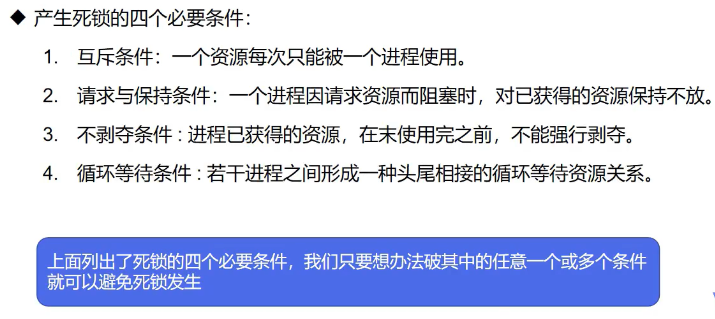
Lock(锁)
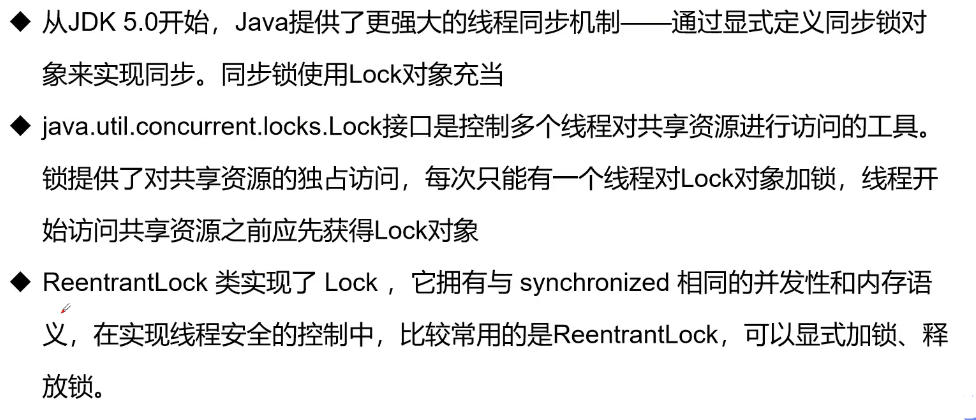
下面使用可重入锁ReentrantLock对共享资源进行显示加锁、解锁:
import java.util.concurrent.locks.ReentrantLock;
public class TestLock {
public static void main(String[] args) {
TestLock2 testLock2 = new TestLock2();
new Thread(testLock2).start();
new Thread(testLock2).start();
new Thread(testLock2).start();
}
}
class TestLock2 implements Runnable{
int ticketNums = 10;
//定义lock锁
private final ReentrantLock lock = new ReentrantLock();
@Override
public void run(){
while(true){
try {
lock.lock(); //加锁
if (ticketNums>0){
try{
Thread.sleep(1000);
}catch (InterruptedException e){
e.printStackTrace();
}
System.out.println(ticketNums--);
}else{
break;
}
}finally {
lock.unlock(); //解锁
}
}
}
}
输出结果:

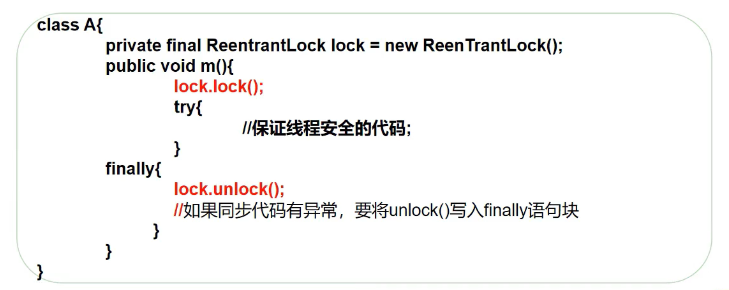
synchronized与Lock的对比

线程协作
生产者消费者问题
线程通信
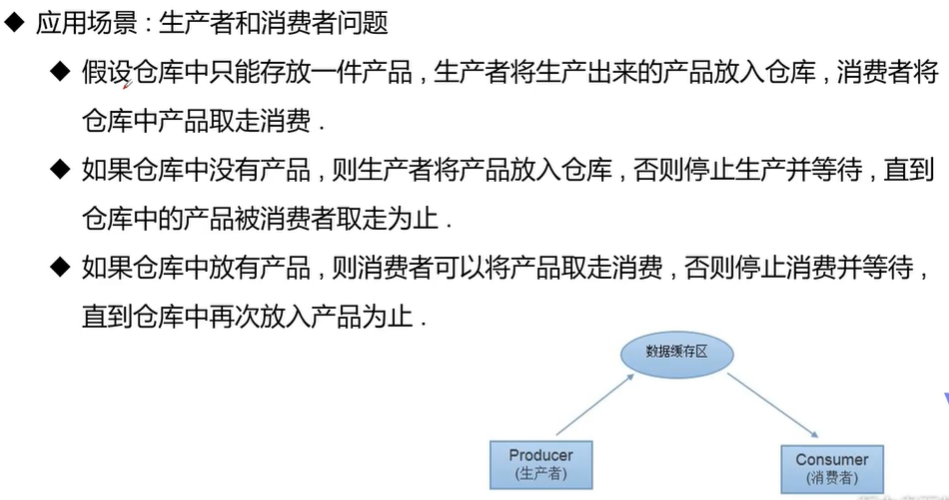

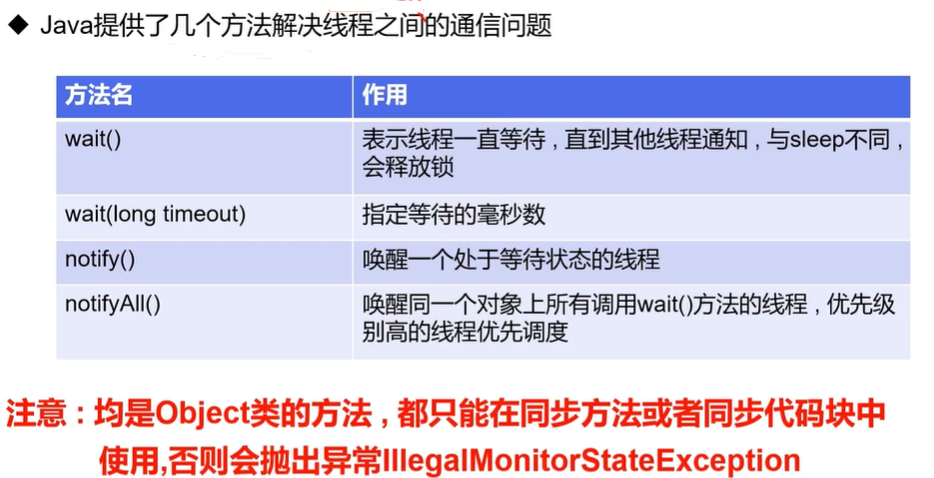
解决方式1
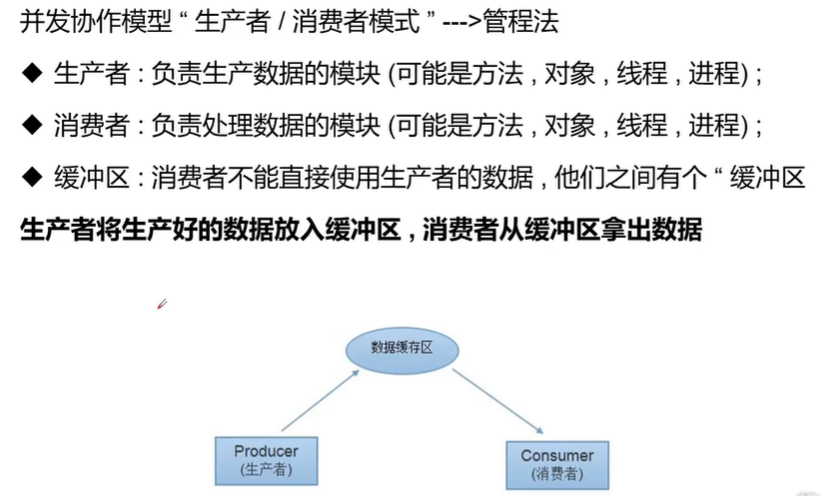
//测试:生产者消费者模型 --->利用缓存区解决:管程法
public class TestPC {
public static void main(String[] args) {
SyncContainer container = new SyncContainer();
new ProviderThread(container).start();
new ConsumerThread(container).start();
}
}
//生产者
class ProviderThread extends Thread {
//创建好的缓冲区
private SyncContainer syncContainer;
public ProviderThread(SyncContainer syncContainer) {
this.syncContainer = syncContainer;
}
@Override
public void run() {
for (int i = 1; i <= 100; i++) {
syncContainer.push(new Product(i));
System.out.println("生产了第" + i + "只鸡!");
}
}
}
//消费者
class ConsumerThread extends Thread {
private SyncContainer syncContainer;
public ConsumerThread(SyncContainer syncContainer) {
this.syncContainer = syncContainer;
}
@Override
public void run() {
for (int i = 1; i <= 100; i++) {
Product pop = syncContainer.pop();
System.out.println("消费了第"+ pop.getId() + "号产品");
}
}
}
//产品
class Product {
private int id;
public Product(int id) {
this.id = id;
}
public int getId() {
return id;
}
public void setId(int id) {
this.id = id;
}
}
//缓冲区
class SyncContainer {
//容器大小,product[0]为空,不使用,即最多放10件产品
Product[] products = new Product[11];
//容器计数器
int count = 0;
//生产者放入产品
public synchronized void push(Product product){
//如果容器满了,就要等待消费者
//这里为什么减2才能实现最多连续存储10只鸡,而减1会出现最多连续存储11只鸡,我不清楚,比较费解
if(count == products.length-2) {
//等待消费者消费,生产者等待
try {
this.wait();
} catch (InterruptedException e){
e.printStackTrace();
}
}
//如果容器没有满,我们就要丢入产品
count++;
products[count] = product;
//可以通知消费者消费
this.notifyAll();
}
//消费者消费产品
public synchronized Product pop(){
//判断容器是否为空
if(count == 0){
//等待生产者生产.消费者等待
try {
this.wait();
} catch (InterruptedException e){
e.printStackTrace();
}
}
//如果可以消费
Product product = products[count];
count--;
//通知生产者生产
this.notifyAll();
return product;
}
}
小疑问:
count == products.length-2 //容器实际能存放10件产品,数组长度为11,减2则count为9,对应product[9],而实际可以存放至product[10],因为下标为0时,不存放产品。为什么-2才能最大连续打至出生产了第10只鸡,而-1会连续打印至生产第11只鸡
输出结果:(符合要求)

解决方式2

//测试生产者消费者问题2:信号灯法,标志位解决
public class TestPC2 {
public static void main(String[] args) {
TV tv = new TV();
new Player(tv).start();
new Watcher(tv).start();
}
}
//生产者-->演员
class Player extends Thread{
TV tv;
public Player(TV tv){
this.tv = tv;
}
@Override
public void run(){
for (int i = 0;i<20;i++){
if (i%2==0){
this.tv.play("快乐大本营播放中");
}else{
this.tv.play("抖音:记录美好生活");
}
}
}
}
//消费之-->观众
class Watcher extends Thread{
TV tv;
public Watcher(TV tv){
this.tv = tv;
}
@Override
public void run(){
for (int i=0;i<20;i++){
tv.watch();
}
}
}
//产品-->节目
class TV {
//演员表演,观众等待 T
//观众观看,演员等待 F
String voice; //表演的节目
boolean flag = true; //flag为真时,观众等待,为假时演员等待
//表演
public synchronized void play(String voice){
if (!flag){
try{
this.wait();
}catch (InterruptedException e){
e.printStackTrace();
}
}
System.out.println("演员表演了:"+voice);
//通知观众观看
this.notifyAll(); //通知唤醒
this.voice = voice;
this.flag = !this.flag;
}
//观看
public synchronized void watch(){
if (flag){
try {
this.wait();
}catch (InterruptedException e){
e.printStackTrace();
}
}
System.out.println("观看了:"+voice);
//通知演员表演
this.notifyAll();
this.flag = !this.flag;
}
}
输出结果:

使用线程池
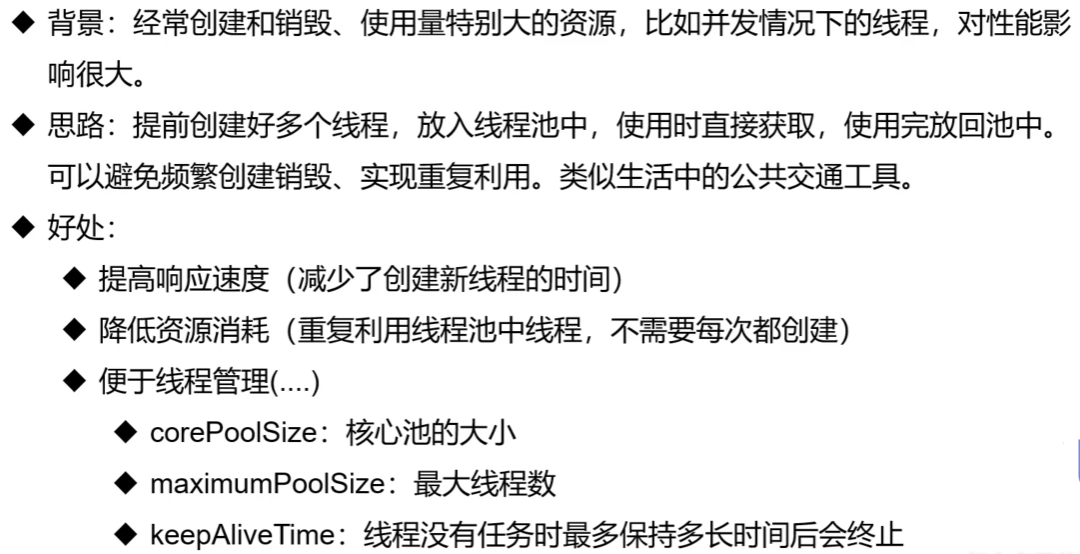
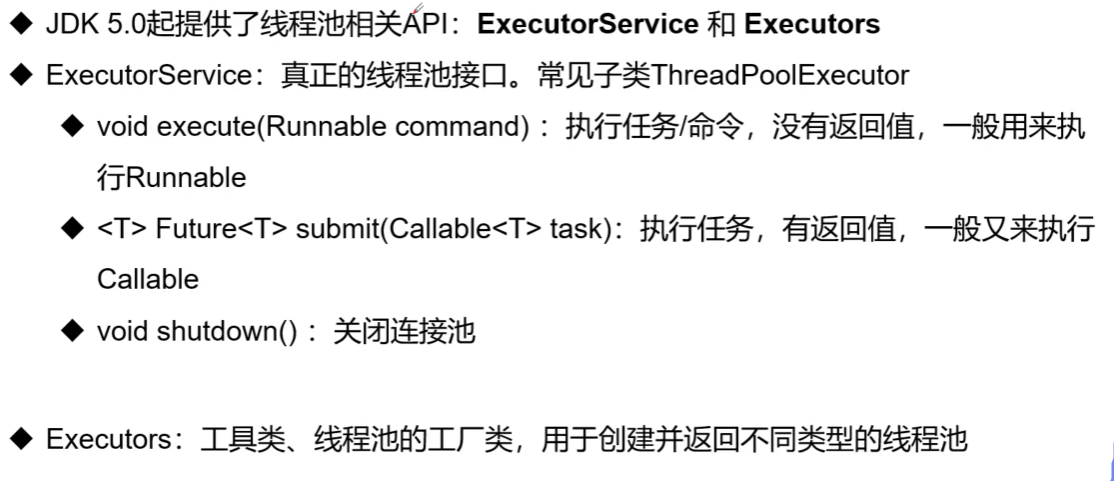
import java.util.concurrent.ExecutorService;
import java.util.concurrent.Executors;
//测试线程池
public class TestPool {
public static void main(String[] args) {
//1.创建服务,创建线程池
//newFixedThreadPool 参数为线程池大小
ExecutorService service = Executors.newFixedThreadPool(10);
//执行runnable接口实现类对象
service.execute(new MyThread());
service.execute(new MyThread());
service.execute(new MyThread());
service.execute(new MyThread());
//2.关闭连接
service.shutdown();
}
}
class MyThread implements Runnable{
@Override
public void run(){
System.out.println(Thread.currentThread().getName());
}
}
输出结果:

package com.ztx.gaoji;
import org.apache.commons.io.FileUtils;
import java.io.File;
import java.io.IOException;
import java.net.URL;
//JUC并发编程
import java.util.concurrent.*;
public class TestCallable implements Callable<Boolean> {
private String url;
private String name;
public TestCallable(String url,String name){
this.url = url;
this.name = name;
}
@Override
public Boolean call() throws Exception {
//下载图片
WebDownloader webDownloader = new WebDownloader();//下载器
webDownloader.downloader(url,name);//下载文件的方式
System.out.println("下载了图片-->"+name);
return true;
}
//启动线程
public static void main(String[] args) throws ExecutionException, InterruptedException {
TestCallable t1 = new TestCallable("https://img2020.cnblogs.com/blog/1732557/202006/1732557-20200617142339091-966351471.png","你好1.jpg");
TestCallable t2 = new TestCallable("https://img2020.cnblogs.com/blog/1732557/202006/1732557-20200617142428143-1598758167.png","你好2.jpg");
TestCallable t3 = new TestCallable("https://img2020.cnblogs.com/blog/1732557/202006/1732557-20200617142459110-1793347461.png","你好3.jpg");
//创建执行服务:
ExecutorService ser = Executors.newFixedThreadPool(3);
//提交执行:
Future<Boolean> result1 = ser.submit(t1);
Future<Boolean> result2 = ser.submit(t2);
Future<Boolean> result3 = ser.submit(t3);
//获取结果
boolean r1 = result1.get();
boolean r2 = result2.get();
boolean r3 = result3.get();
//判断线程是否顺利结束或者有异常
System.out.println(r1);
System.out.println(r2);
System.out.println(r3);
//关闭服务
ser.shutdownNow();
}
}
//下载图片
class WebDownloader{
//下载方法
public void downloader(String url,String name){
try {
FileUtils.copyURLToFile(new URL(url),new File(name));
} catch (IOException e) {
e.printStackTrace();
//输出异常信息
System.out.println("downloader方法出现异常");
}
}
}
输出结果:





 浙公网安备 33010602011771号
浙公网安备 33010602011771号